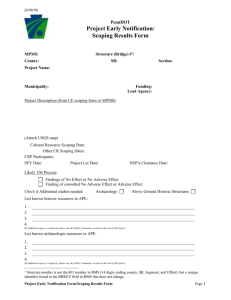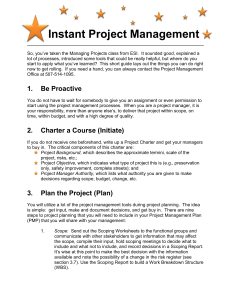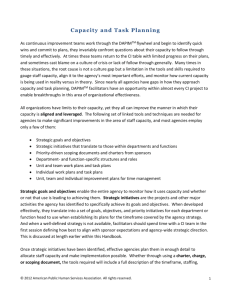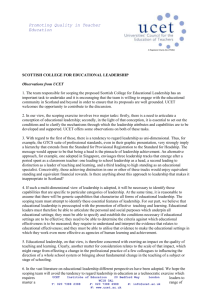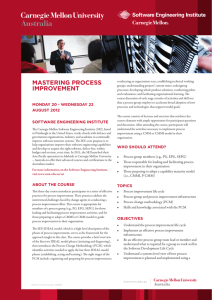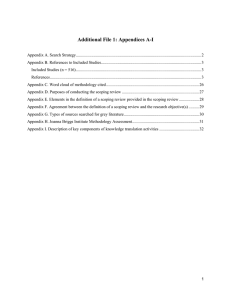dengzhangminiproject
advertisement
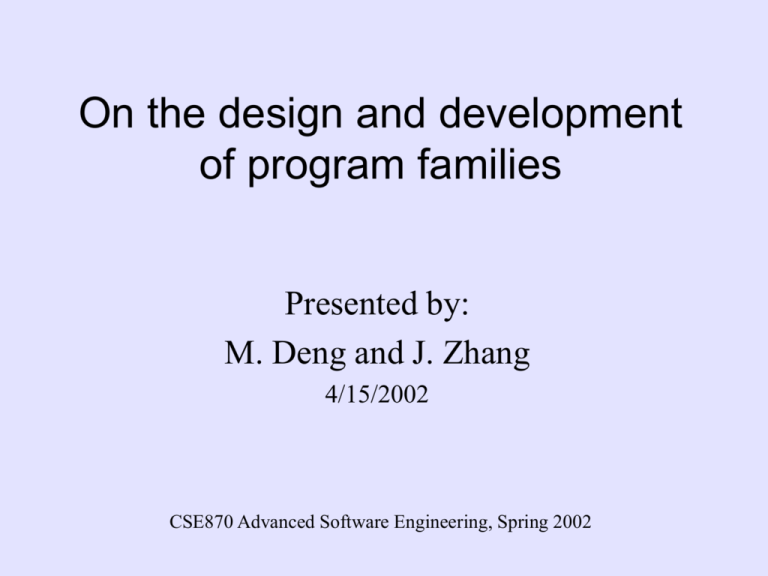
On the design and development of program families Presented by: M. Deng and J. Zhang 4/15/2002 CSE870 Advanced Software Engineering, Spring 2002 Overview • Objective – Definition of program families • A set of programs – First common features of these programs – Then variation of each program • Example: Microsoft Office Family – Three techniques • Traditional method: Sequential development method • Two new methods: – Stepwise refinement method – Specification of information hiding modules method [Parnas76] David Parnas, “On the design and development of program families,” IEEE Transactions on Software Engineering, SE-2(1), 1-9, 1976. Overview (cont’d) • Technique Overview – Sequential Method • Features • Disadvantages 4 6 5 start 0 start point 1 an incomplete program 2 a complete program 3 7 8 Overview (cont’d) – Stepwise Method Vs. Specification Method • Features • Combination start 0 1 start point 2 3 an incomplete program 6 a complete program 4 5 7 Impact • Product line – Definition: a group of products that share a set of commonalities that meet the requirements of the market – CMU/SEI: a Framework of Software Product Line Practice – CMU/SEI: 1st Software Product Line Conference (SPLC1) in 2000 • Information hiding design principle in ObjectOriented programming languages • And so on Related 1: Commonality Analysis • Objective – To identify the common features and variations among family members • Technique Overview – FAST (Family-oriented Abstraction, Specification and Translation) process – An early step of the FAST process – Participants: • Moderator, recorder, family analysis experts [Weiss98] David Weiss, “Commonality Analysis: A Systematic Process for Defining Families,” in 2nd International Workshop on Development and Evolution of Software Architectures for Product Families, February 1998. Related 1 (cont’d) – Result: Commonality Analysis Document – Form: to hold a series of meetings • Five stages: – – – – – Prepare Plan Analyze: central part Quantify Review – Applicability: • Has been practiced in Lucent Technologies • How it extends Parnas’ work? – Provide a process Related 2: Adaptable Components • Objective – One component represents a family of components • Technique Overview – An adaptable component has a group of parameters of adaptability [Campbell99] Grady Campbell, “Adaptable Components,” in Proceeding of 21st International Conference on Software Engineering (ICSE99), ACM, 685-686, 1999. Related 2 (cont’d) – Two models of reuse: • Usual reuse model – Select from a library of components – Customize and then construct a new component – Time-consuming, error-prone • Adaptable component based reuse model – Select from the name of adaptable component – Make the decisions of parameters • How it extends Parnas’ work? – A component family Related 3: Combining Product Line Engineering with Options Thinking • Objective – To introduce an appropriate economic model to justify the use of product line approach • Technique Overview – Product line approach needs more initial investment – The DCF Model can be used to justify the use of product line in cell phone companies – The DCF is not suitable to justify product line approach in an evolutionary product – The BSOP Model is a Model used in stock market to value the option. It is more suitable to justify an evolutionary product [Geppert01] Birgit Geppert and Frank Roessler, “Combining Product Line Engineering with Options Thinking,” in Proceedings of Product Line Engineering: The Early Steps (PLEES’01), September 2001. Related 3 (cont’d) • How it extends Parnas’ work – Product line is an extension of program family – This work introduces an economic model to justify the use of the product line Uncited: Multi-Staged Scoping for Software Product Lines • Objective – To propose a scoping method for the product line approach • Technique Overview – Why we need scoping? – What requirements a sound scoping method should meet? – Three components of the proposed scoping method • Product line mapping, domain based scoping, feature based scoping [Schmid00] Klaus Schmid, “Multi-Staged Scoping for Software Product Lines,” in Proceedings of Software Product Lines: Economics, Architecture, and Implications, June 2000. Why it should have cited the paper • This paper should have cited Parnas’ paper for the same reason as the previous paper – Product line is a industrial interpretation of program family – This paper proposes a scoping method in product line References • D. Parnas, “On the design and development of program families,” IEEE Transactions on Software Engineering, SE-2(1), 1-9, 1976. • http://www.sei.cmu.edu/plp/product_line_overview.html. • http://www.sei.cmu.edu/plp/conf/SPLC.html. • http://www.sei.cmu.edu/plp/framework.html. • D. Weiss, “Commonality Analysis: A Systematic Process for Defining Families,” in 2nd International Workshop on Development and Evolution of Software Architectures for Product Families, February 1998. • G. Campbell, “Adaptable Components,” in Proceeding of 21st International Conference on Software Engineering (ICSE99), ACM, 685-686, 1999. References • B. Geppert and F. Roessler, “Combining Product Line Engineering with Options Thinking,” in Proceedings of Product Line Engineering: The Early Steps (PLEES’01), September 2001. • K. Schmid, “Multi-Staged Scoping for Software Product Lines,” in Proceedings of Software Product Lines: Economics, Architecture, and Implications, June 2000.
